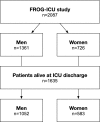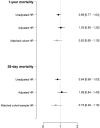Gender and survival of critically ill patients: results from the FROG-ICU study
- PMID: 30927096
- PMCID: PMC6441070
- DOI: 10.1186/s13613-019-0514-y
Gender and survival of critically ill patients: results from the FROG-ICU study
Abstract
Purpose: Few studies analyzed gender-related outcome differences of critically ill patients and found inconsistent results. This study aimed to test the independent association of gender and long-term survival of ICU patients.
Materials and methods: FROG-ICU was a prospective, observational, multi-center cohort designed to investigate the long-term mortality of critically ill adult patients. The primary endpoint of this study was 1-year mortality after ICU admission of women compared to men.
Results: The study included 2087 patients, 726 women and 1361 men. Women and men had similar baseline characteristics, clinical presentation, and disease severity. No significant difference in 1-year mortality was found between women and men (34.9% vs. 37.9%, P = 0.18). After multivariable adjustment, no difference in the hazard of death was observed [HR 0.99 (95% CI 0.77-1.28)]. Similar 1-year survival between women and men was found in a propensity score-matched patient cohort of 506 patients [HR 0.79 (95% CI 0.54-1.14)].
Conclusion: Women constituted one-third of the population of critically ill patients and were unexpectedly similar to men regarding demographic characteristics, clinical presentation, and disease severity and had similar risk of death at 1 year after ICU admission. Trial registration ClinicalTrials.gov NCT01367093; registered on June 6, 2011.
Keywords: Critically ill; Female; Gender; ICU; Mortality; Outcome; Women.
Conflict of interest statement
Etienne Gayat received a research grant from Sphingotec, consultancy fees from Magnisense, Roche Diagnostics. Alexandre Mebazaa received speaker’s honoraria from Abbott, Novartis, Orion, Roche et Servier and fee as a member of the advisory board and/or Steering Committee from Cardiorentis, Adrenomed, MyCartis, Neurotronik, and Sphingotec. Mattia Arrigo received speaker’s honoraria from Orion. All other co-authors have no conflict of interest related to the present manuscript.
Figures




References
-
- Capuzzo M, Volta C, Tassinati T, Moreno R, Valentin A, Guidet B, et al. Hospital mortality of adults admitted to Intensive care units in hospitals with and without intermediate care units: a multicentre European cohort study. Crit Care. 2014;18(5):551. doi: 10.1186/s13054-014-0551-8. - DOI - PMC - PubMed
Associated data
Grants and funding
LinkOut - more resources
Full Text Sources
Medical

